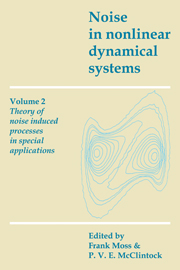Book contents
- Frontmatter
- Contents
- List of contributors
- Preface
- Introduction to Volume 2
- 1 Stochastic processes in quantum mechanical settings
- 2 Self-diffusion in non-Markovian condensed-matter systems
- 3 Escape from the underdamped potential well
- 4 Effect of noise on discrete dynamical systems with multiple attractors
- 5 Discrete dynamics perturbed by weak noise
- 6 Bifurcation behavior under modulated control parameters
- 7 Period doubling bifurcations: what good are they?
- 8 Noise-induced transitions
- 9 Mechanisms for noise-induced transitions in chemical systems
- 10 State selection dynamics in symmetry-breaking transitions
- 11 Noise in a ring-laser gyroscope
- 12 Control of noise by noise and applications to optical systems
- 13 Transition probabilities and spectral density of fluctuations of noise driven bistable systems
- Index
1 - Stochastic processes in quantum mechanical settings
Published online by Cambridge University Press: 05 January 2012
- Frontmatter
- Contents
- List of contributors
- Preface
- Introduction to Volume 2
- 1 Stochastic processes in quantum mechanical settings
- 2 Self-diffusion in non-Markovian condensed-matter systems
- 3 Escape from the underdamped potential well
- 4 Effect of noise on discrete dynamical systems with multiple attractors
- 5 Discrete dynamics perturbed by weak noise
- 6 Bifurcation behavior under modulated control parameters
- 7 Period doubling bifurcations: what good are they?
- 8 Noise-induced transitions
- 9 Mechanisms for noise-induced transitions in chemical systems
- 10 State selection dynamics in symmetry-breaking transitions
- 11 Noise in a ring-laser gyroscope
- 12 Control of noise by noise and applications to optical systems
- 13 Transition probabilities and spectral density of fluctuations of noise driven bistable systems
- Index
Summary
Introduction
The apparent generality of the title to this chapter is appropriately reduced by sufficiently precisely defining the terms used. We have in mind the natural extension to quantum mechanical settings of the ideas usually covered in a discussion of stochastic processes in classical mechanical settings. In classical mechanical settings, the fundamental process is Brownian motion, which describes the influence of external fluctuating forces on a small particle. The mathematical apparatus developed for the study of Brownian motion has been generalized and applied to irreversible thermodynamics (Onsager and Machlup, 1953), fluctuating hydrodynamics (Fox and Uhlenbeck, 1970), light scattering from fluids and mixtures (Berne and Pecora, 1976) and chemical reactions (McQuarrie and Keizer, 1981). In each case, the stochastic process involves fluctuations generated by thermal motions. We are not considering the stochastic trajectories (chaos) of classically deterministic motion in non-linear systems (Lichtenberg and Lieberman, 1983), which is an entirely separate context for stochastic processes. Our goal in this chapter is to study the effects of thermal fluctuations in quantum mechanical settings. Therefore, we exclude a discussion of interpreting quantum mechanics as a classical stochastic motion (Nelson, 1966), an idea which should have been put to rest by Grabert, Hänggi and Talkner (1979). We also exclude a discussion of quantum chaos, which is currently a very active area of research (Zaslavsky, 1981).
Just as Brownian motion provides the paradigm for stochastic processes in classical mechanical settings, the Anderson–Kubo oscillator (Anderson, 1954; Kubo, 1954; Kubo, Toda and Nashitsume, 1985) is the paradigm for stochastic processes in quantum mechanical settings.
- Type
- Chapter
- Information
- Noise in Nonlinear Dynamical Systems , pp. 1 - 23Publisher: Cambridge University PressPrint publication year: 1989



